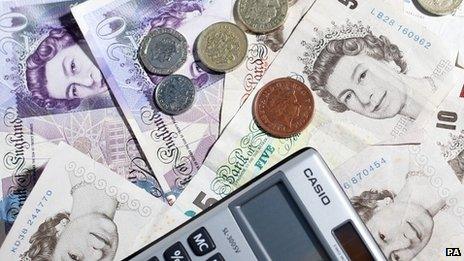Public sector hourly pay outstrips private sector pay
- Published

Public sector workers are paid on average 14.5% more than those in the private sector, according to the Office for National Statistics (ONS).
In 2013, average hourly earnings in the public sector were £16.28 an hour, compared to the average £14.16 among private employees.
But the difference was skewed because more public sector jobs require high levels of skill and university degrees.
Public sector employers also tend to be larger, thus paying higher wages.
Stripping out the influence of various job and personal characteristics - not just the effect of jobs requiring high levels of skill or higher educational qualifications, but also factors like age, experience, gender and location of the jobs - then the pay difference in favour of the public sector shrank to between 2.2% and 3.1%.
And if the tendency for big employers - those with more than 500 staff - to pay higher wages was also removed, then the balance of average pay moved in favour of the private sector as the public sector is mainly made up of large employers.
The ONS said that taking all those factors into account, then the private sector's average weekly pay rates in 2013 were in fact between 1.3% and 2.4% higher than those of the public sector.
"Average pay levels vary between the public and private sectors because of the different jobs and characteristics of the people within each sector," said the ONS.
"The average pay difference in favour of the public sector has narrowed since the year 2010, which in part reflects the restraints on public sector pay over this period," it said.
The top 5%
The figures used for the ONS analysis came from its Annual Survey of Hours and Earnings, external, a survey of 1% of all tax returns of people in employment - but not the self-employed.
Overtime pay was not included in the public/private sector analysis, and the value of pension contributions, company cars or health insurance are not covered by ASHE anyway.
The ONS found that if rates of pay were compared by calculating median pay (the middle pay point of the range of pay rates being sampled), then the superiority of public sector pay was even higher - a 35% difference.
That amounted to public sector staff being paid £3.67 per hour more than the private sector's employees.
The survey results were not all one-way traffic in favour of the public sector.
While those in the bottom 5% of staff in the two groups were paid more if they were in the public sector, the highest-paid earners in each of the two groups were paid more if they were in the private sector.
"Looking at the top 5%, in the public sector earnings are greater than £31.49 per hour, while in the private sector, the top 5% earn more than £33.63 per hour," the ONS said.
"The top 1% of earners in the private sector, at more than £60.21 per hour, earns considerably more than the top 1% of earners in the public sector, at more than £49.65 per hour."